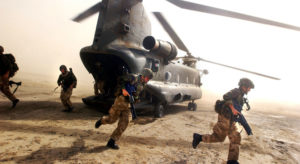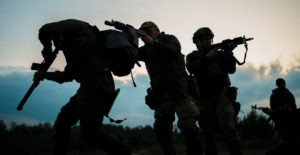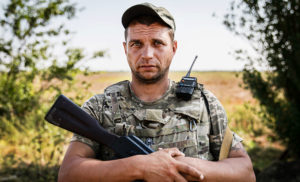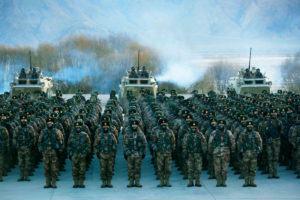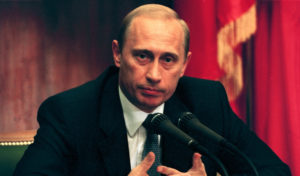In 2008, at a birthday party in Fulham, a 26-year-old aspiring portrait painter met the adjutant of the Household Cavalry Mounted Regiment. As the section of the British Army that performs ceremonial duties with horses, the regiment is often judged on appearances. Ed Olver, a captain, explained that he was looking for an artist to update a nineteenth-century canvas.
In the officers’ mess at Hyde Park Barracks, there hung a depiction of the regiment’s officers from 1857. It showed an all-male, blue-blooded ensemble, in elaborate dress. The new painting was to take the same format, but was meant to showcase how the Household Cavalry — traditionally the socially “smartest” section of the British Army — had changed. The unit now had black and Sikh officers. In common with other infantry and armoured units at the time, there were still no women formally within the regiment, but there were some working with it, including a vet.
The young painter, Louise Pragnell, agreed to take on the project. In time, the huge 3m-by-1m painting almost drove her insane. The resulting image also embodied the British Army’s confused attitude to diversity in the 21st century.
Olver explained the concept: “We’ve got these two women here, and we’ve got a Sikh and we’ve got two black guys.” The sitting took place in May 2008 at the barracks south of the Serpentine. The 25 subjects wore a variety of dress, from ceremonial “state kit” with its gleaming breastplate to the scarlet bum-freezer jacket of mess kit, service dress, or combats. Some eschewed uniform altogether, coming in polo kit, hunting gear and Ascot tails. There was a strong equine theme.
As a message, the scene was a mixed one: we have black people, it said. We have women. But we’re all still really posh. Notably, both the black officers — one Ghanaian, the other Zimbabwean — spoke with received pronunciation. Meanwhile, one sitter liked the idea of a soldier servant pouring him a glass of champagne while he stared imperiously in the other direction. That hardly seemed to concur with the diversity message, but Pragnell included it.
I’m always reminded of these mixed messages, whenever a row erupts about diversity in the British military. In August, the head of Royal Air Force recruitment resigned, reportedly due to a focus on hitting “impossible” diversity targets. (In response James Heappey, the armed forces minister, denied claims that job offers for white men had been put on “pause” to achieve such targets, clarifying that air force leadership had paused offering training slots to all candidates while they examined how they might take legal steps — so-called positive action — to assist improving diversity levels on courses.)
Earlier in the year, shortly before the Russian invasion of Ukraine, the British Army put all non-essential work on hold for a “diversity training day”, to address concerns including drug and alcohol abuse, bullying and racism. In his first speech in post last December, Admiral Tony Radakin, professional head of the armed forces, said that diversity is “not about wokefulness”. “It is about woefulness,” he added. “The woefulness of too few women. The woefulness of not reflecting the ethnic, religious and cognitive diversity of our nation.”
Indeed, the British Armed Forces have long failed to reflect the society they are tasked to defend. The full-time military is still 90.4% white and 88.7% male. Female representation is roughly equal between the services, but ethnic minorities make up 14% of the army (in which 40% of ethnic minority personnel originate from abroad), compared to 4.9% of the Royal Navy and Royal Marines, and only 3.5% of the air force.
Meanwhile, there is an elephant in the room when it comes to military diversity: social class. Just as Louise Pragnell’s painting displayed ethnic diversity but class homogeneity, all three services are still split into distinct commissioned and non-commissioned universes — between officers and soldiers, in army language. Each track features its own entry requirements and career trajectories. And this split is traditionally based on class: historically, officers were posh; the soldiers were not.
There is some movement between these worlds. For instance, the army sends some promising young soldiers to train at the officer academy at Sandhurst, alongside direct-entry, predominantly graduate cadets. At the other end of the spectrum, there is also now no section of the army where it is impossible to live on your pay as an officer — in the past high mess bills and the prohibitive costs of tailored uniforms could mean a private income was required. Nonetheless, the officer-soldier divide is still the defining fault line in the military’s organisation, and it is most acute in the army. In 2019, 49% of Sandhurst direct-entrant cadets had attended fee-paying schools — whereas the equivalent figure for the Royal Naval College at Dartmouth was 36%. (The RAF does not gather information on educational background.)
Britain’s military institutions are pushing a race and gender diversity agenda, while largely failing to acknowledge that their basic shape is still profoundly non-egalitarian. British Army recruiting adverts released in 2018 included short, animated advertisements with titles like “Can I be gay in the Army?” and “Can I practise my faith in the army?” They did not ask “Will I have to call someone younger and less experienced than me ‘sir’?” or “Can I get into a smart regiment if I don’t know that shirts with single cuffs are taboo?”
An official Ministry of Defence action plan, leaked in August, aimed to “build defence into an institutionally inclusive organisation” and “to drive significant change by ensuring that race equality is a driving principle in defence”. Every time something like this happens, anonymous Whitehall sources brief “dereliction of duty” and Tory MPs spit fire about quotas, but no one tends to remark that the diversity initiatives speak less loudly about class than race and gender. People simply accuse the military of putting diversity ahead of defence.
It is worth considering, then, whether diversity initiatives actually make the military a more effective fighting organisation. On class and race, I would suggest the arguments are clear-cut. If the army, in particular, can break away from its traditional upper-middle class leadership cadre by recruiting more working-class and non-white officers, it is likely to be less hidebound by tradition. That is important. For all the pomp of the queen’s funeral, wars are not won by polishing things.
In my book, I focus on a cavalry regiment in the run-up to and during the initial invasion of Iraq in 2003. This organisation — pickled in alcohol, obsessed with standards of tailoring and mess etiquette (junior officers weren’t allowed to go to bed until everyone senior to them had departed), even as the drums of war began to beat, now seems picaresque and bizarre. But that ossification came in part from decades of recruiting the same kind of people, putting them through a brutal process of hazing, and then ensuring they replicated that treatment on those that succeeded them. Recruitment across wider social background shakes up things like that.
The full integration of women is more complex. The ban on women in combat roles — infantry or armoured units — was not lifted until 2016, two years after Britain withdrew from Helmand. But the reality of the Iraq and Afghan conflicts, in which there were no front lines, meant that female soldiers, for instance medics attached to infantry patrols, took the same risks as men. “Some of the best soldiers and most promising officers I know are women,” said General Patrick Sanders, at a ceremony in 2018 to mark all roles in the army becoming open to women. “Simply put the infantry will be more effective in war if we include the best talent our country can breed — male and female.”
But whether opening armoured and infantry roles to women has improved the army is a complicated question. During the several hundred interviews I conducted for my book, I found that opinion is split. There was clear respect, even from relatively old-fashioned men, for the achievements of women. Many I spoke to suggested that naysayers had been proved wrong. Yet at the same time most men from the combat arms, soldiers and officers alike, remained — in private at least — opposed to the formal integration of women into their units. My sense is that the 2016-18 reform reflected the army leadership’s feeling that keeping some units male-only was now politically impossible, rather than a belief that it would create the most militarily effective army. (“This decision wasn’t forced upon us,” Sanders insisted).
Whenever the subject of women in “ground combat’ is raised there tends to be a lot of sexist and poorly-informed chatter about supposedly innate personality differences or the impact on male behaviour of having women nearby. Much of that is bunkum, as the bravery and effectiveness of female soldiers in Iraq and Afghanistan attests. But there does remain an unassailable difficulty: physical requirements.
Many crucial jobs in the contemporary military do not require physical strength. But some do, and within infantry soldiering the ability to move long distances on foot carrying weight remains essential. Some exceptional women can meet and beat fitness requirements designed for men, but they are a minority. The US Army envisioned a gender-neutral new fitness test in 2017, but trials found that only 41-52% of enlisted women were passing, compared to 83-92% of men, depending on the component of the test. Among officers the pass rates were higher, but there was still a significant difference. When the test was actually implemented this year, gender neutral scoring had to be abolished. For example, in the deadlift component, women between the ages 17-21 have to lift 54kg to pass. Men in the same age group have to lift 64kg.
In general, integrating women into ground combat units requires one of two approaches. Either the existing fitness standards are maintained, which effectively means only small numbers of women will qualify. That dooms those exceptional female performers to a kind of tokenistic existence — and isolated women, in units where the hierarchy remains male-dominated, can face the worst of military sexism and harassment.
The British Army moved to a gender-neutral fitness tests in 2018, with then-field army sergeant major Gavin Paton remarking: “I don’t care if you are a man or a woman, I don’t care what you do, and the enemy doesn’t either.” Notably though, while the test is formally gender-neutral, there are various distinctions depending on one’s role. For instance, Infantry and Royal Armoured Corps troops are expected to complete a 2km run within 9 minutes and 45 seconds, with paratroopers expected to achieve that in 8:15. This means that women in elite units will be few, which can create hazards. Imagine being one of a handful of newly-arrived women in a Parachute battalion when a video emerges, as it did in June, of your colleagues engaged in an orgy (albeit consensual) with a civilian woman.
The alternative is to alter physical standards so that women will pass in greater numbers. That expands female presence beyond the tokenistic, and creates a pipeline for female leadership. But lowering fitness bars also alters the fundamental nature of a unit, and, to an extent, its capabilities.
For eight years after the Afghan withdrawal in 2014, the British Army suffered an identity crisis — it could make no cogent case for what it was for as an institution. The Russian invasion of Ukraine changed that. “This is our 1937 moment,” Patrick Sanders remarked in June. But if the British military’s purpose is now to deter Russian aggression, then fighting efficiently should be the key metric for policy. On those terms, the actual size of the army matters. But so does determining which diversity initiatives help, what gets hidden, and what is worthwhile but fundamentally complex.
It’s also worth recognising that surface-level reform can hide lingering prejudice, as the conclusion of Louise Pragnell’s project to paint the Household Cavalry showed. The huge image was finally unveiled over lunch in 2010, at the mess at Knightsbridge. The regiment invited Lucian Freud, who had painted a former Household Cavalry officer, Andrew Parker-Bowles, in 2003. In The Brigadier, the ex-husband of our new Queen is decked out in swanky garb, with scarlet stripes down his trousers, but his pose is aloof: he is thrown back in an armchair, jacket unbuttoned and belly spilling out.
At the unveiling, Freud, an octogenarian by this point, with advancing Alzheimer’s, kept forgetting what was going on.
“Who are these people?” he asked Pragnell. Around the table, everyone was pretending to talk while in fact listening to what he was saying.
“They’re officers of the household cavalry,” Pragnell replied.
“So why is there a negro here?” Freud asked.
You could hear a pin drop. All at once, the whole awkwardness of the regiment’s diversity experiment was dragged into the open; the fundamental weirdness of “we’ve got two women and two black guys but we’re still posh” was exposed.
Disclaimer
Some of the posts we share are controversial and we do not necessarily agree with them in the whole extend. Sometimes we agree with the content or part of it but we do not agree with the narration or language. Nevertheless we find them somehow interesting, valuable and/or informative or we share them, because we strongly believe in freedom of speech, free press and journalism. We strongly encourage you to have a critical approach to all the content, do your own research and analysis to build your own opinion.
We would be glad to have your feedback.
Source: UnHerd Read the original article here: https://unherd.com/

